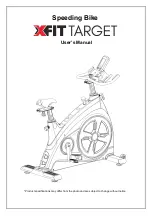
- 7 -
GB
Do not
pierce the battery with any sharp objects, strike the battery with a hammer / tools, step on the battery,
or otherwise subject it to strong impacts or shocks.
Do not
place the battery in fi re or apply heat to the battery. Never short circuit the end elements of the battery
with any metal objects due to the risk of burns, fi re and explosion. Never carry or store the battery together
with necklaces, hairpins, or other metal objects.
WARNING – Do not disassemble or modify the battery!
Safety mechanisms are incorporated in the battery which if damaged may cause the battery to generate heat,
rupture, explode or ignite.
WARNING – Do not place the battery on or near fi res, or other high-temperature locations.
Do not
place the battery in direct sunshine. Doing so may cause the battery to generate heat, rupture or ignite.
Using the battery in this manner may also result in a loss of performance and shortened life expectance.
WARNING – In case of fi re, DO NOT THROW WATER ON A BURNING BATTERY!
A class C fi re extinguisher (according to European Regulation EN 3) must be used.
WARNING – Damaged or exhausted battery disposal.
Dispose a damaged or exhausted battery after taking the necessary steps to prevent external short circuit
by the following method:
After having insulated the terminals of the battery with insulating tape, dispose off under the law or in
accordance with the local council.
3.2.4
BATTERY – Information
• Time to charge empty or new battery: approx. 3 hours.
NOTE – NEW Battery: fi rst charging
For the fi rst charge, this process will take about
3 hours
. New batteries or batteries stored for
a long time may take more time to charge. The battery will reach its full capacity after a few full
charge / discharge cycles.
NOTE
Place the hand piece into the charging unit after each treatment, or when not in use.
• Operating
condition:
Operating temperature:
10°C (50°F) up to 35°C (95°F).
Relative humidity:
45% to 85% RH.
Atmospheric pressure:
800 hPa to 1060 hPa.
CAUTION
The temperature and relative humidity ranges over which the battery can be charged is 10°C (50°F) to
35°C (95°F), and 45% to 85% RH. Charging the battery at temperatures outside of this range may cause
the battery to become hot or damaged. Charging the battery outside this temperature range may also harm
the performance of the battery or reduce the battery’s life expectancy.
• Battery transportation and storage conditions:
Recommended temperature and relative humidity ranges:
–20°C (–4°F) to 40°C (104°F) and 45% to 85% RH.
Always store the battery charged and not for longer than 5 months.
Ambient air pressure:
500 hPa to 1060 hPa.
NOTE
Always fully charge the battery before an extended period of inactivity of the device and at least once
every 5 months.
In case of extended period of inactivity replace the battery from the hand piece.
• Battery Typical Life Characteristics:
The Translux 2Wave battery has a typical life expectancy of 300 – 400 charging cycles depending on the
application and environmental conditions in which it is used.
NOTE
The battery is a chemical product utilising a chemical reaction, so the performance will deteriorate not only
through use but also with the passage of time even if it left unused.
1707_11667_GBA_Translux_2Wave_EU_NENA.indb GB7
1707_11667_GBA_Translux_2Wave_EU_NENA.indb GB7
07.09.17 16:21
07.09.17 16:21
















































